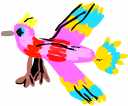
|
|
The
Secret World of Drawings: by
|
Excerpted
from
THE SECRET WORLD OF DRAWINGS: A Jungian Approach to
Healing through Art by Gregg M. Furth (title 99, 100 illustrations, $20),
appearing in Jung at Heart, Number 36, Winter/Spring 2002. Inner City
Books. All rights reserved. Reprinted with Permission.
"Art " versus pictures from the unconscious
Let us differentiate between pictures from the unconscious and art as produced by the world’s great artists. In both creations, the content derives from similar layers of the unconscious. Pictures from the unconscious represent primitive, raw material taken directly from the unconscious, undeveloped yet filled with the unconscious content closely connected to the person’s complexes. Naturally, some of these pictures could be great masterpieces.
However, artists use their creative power, both conscious and unconscious— their world of opposites—in a total way to produce works of art.
For the artist, the masterpiece is the culmination of conscious and unconscious development, the result of years of observation and study of artistic technique, as well as personal experience that may or may not be consciously remembered, along with the innate psychology of the artist, and of course including his or her connection to the collective unconscious. Thus the acknowledged “work of art” speaks not only for the individual psyche, but also, in deeply unconscious ways, for the collective psyche.
Both the artist and anyone drawing pictures from the unconscious may be prompted by inner necessity. What would Michelangelo, Picasso or Dali have done had they been forbidden to paint? Perhaps society would have had to institutionalize them. Artists need to paint; they seem unable not to create. Anyone can feel the same; few can refrain from “doodling,” for instance, in meetings, during long telephone conversations and so on. The artist within feels a compelling need to produce, and these productions are representative of one’s psychology.
While the artist is interested in aesthetics and technique as well as the drawing or painting’s feeling tone, for pictures from the unconscious all considerations but that of feeling tone are irrelevant, since the value of the pictures is in the psychic expression itself.
Naturally, the pictures from the unconscious that we ourselves draw have more of a feeling tone related to them. Aesthetic considerations in such cases are less important than the power of activated unconscious elements.
It is interesting to note that when professional artists produce pictures from the unconscious, they frequently become aware of a flow of inner good feelings accompanying their work. They seem to be expressing a freedom they have not felt in years, or awakening memories of using media associated with good feelings experienced years ago.
Pictures from the unconscious executed by artists are in fact often awkward and childlike, even primitive, and very similar to those by non-artists. Any drawing has a cathartic effect, and that catharsis allows the healing process to begin.
When pictures emerge from the unconscious, they bear a tremendous amount of psychic information. The idea is not to decipher with accuracy what is within the picture—in order to predict the person’s future, for instance—but to ask concise questions as to what it may be communicating. This communication lays bare the unconscious and its energy.
If we want to learn from our unconscious, we need to be aware of its suggestions and contents. Spontaneous drawings and paintings are an excellent way to gain that “secret” knowledge, which as it happens is available to us all.
©Inner City Books, Box 1271, Station Q, Toronto, ON M4T 2P4, Canada JUNG at HEART, No. 36, Winter/Spring 2002
![]()
888-777-3773
